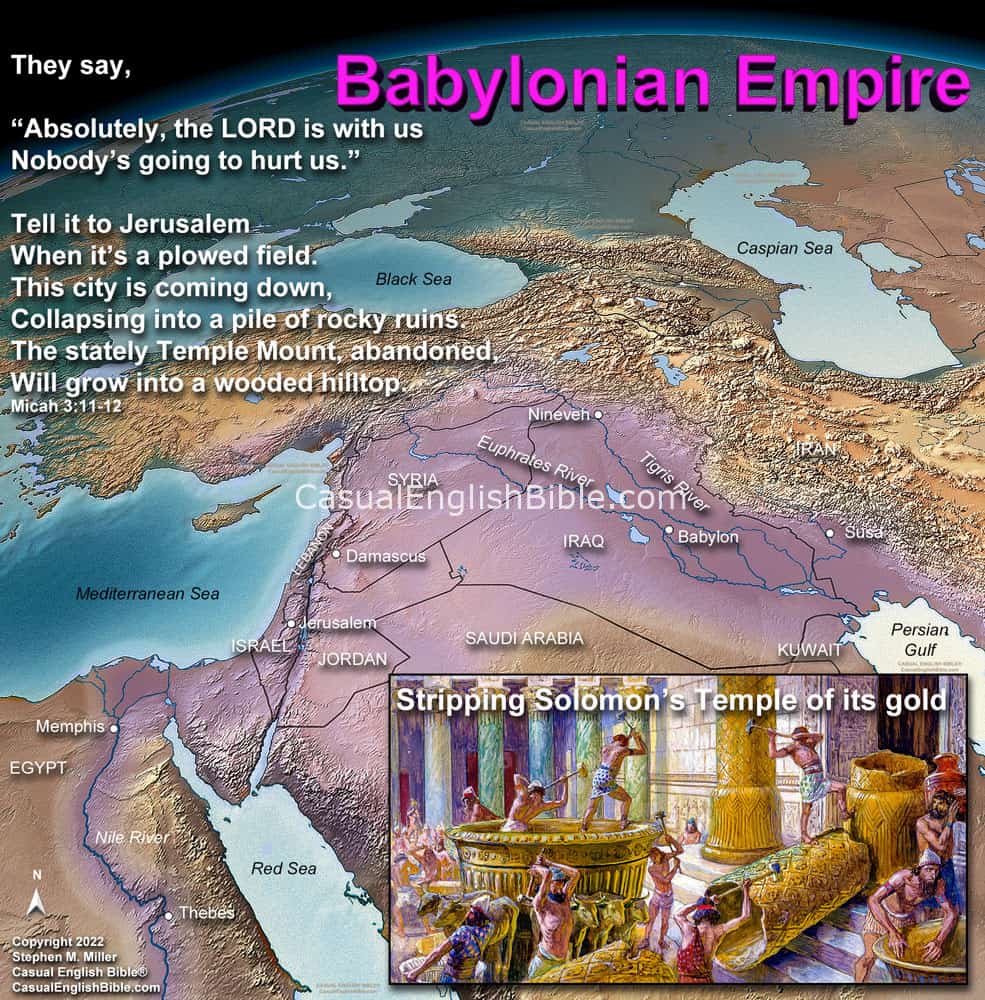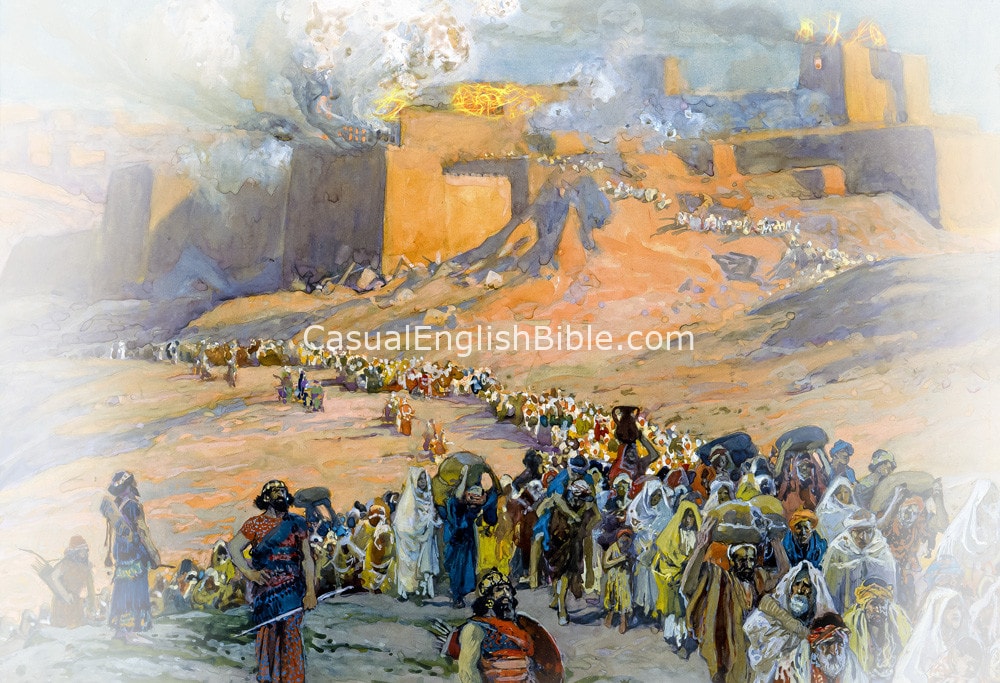2 Kings 24
Babylon comes to town
Babylon’s fresh meat: Judah
1Babylonian King Nebuchadnezzar [1] invaded Judah. [2] His armies captured the cities, arrested Judah’s King Jehoiakim, and forced Judah to pledge allegiance to Babylon. That lasted three years. Then King Jehoiakim rebelled.2That’s when the LORD sent prophets to warn the people of Judah that raiders were coming. Then the LORD unleashed the raiders. Intruders came from Babylon, Syria, Moab, and Ammon. The LORD sent them to attack and destroy. 3The LORD did this to punish the people of Judah for enabling and embracing the massive sins of King Manasseh. [3] 4That king murdered enough innocent people to paint Jerusalem red with their blood. The LORD wasn’t willing to let that slide.
5The rest of Jehoiakim’s story and all he accomplished are recorded in the History of Judah’s Kings. [4] 6Jehoiakim died and his son Jehoiachin became the next king.
7Down on Judah’s border with Egypt, Babylonians blocked Egyptians from traveling anywhere north of Egypt’s border with Judah. Babylon controlled all the land from the Dry Creek [5] of Egypt to the Euphrates River. [6]
King Jehoiachin in captivity
(2 Chronicles 36:9-10) 8Jehoiachin was 18 years old when he became king of Judah. He reigned in Jerusalem for three months. His mother was Nehushta. She was the daughter of Elnathan, a citizen of Jerusalem. 9Jehoiachin was an evil king, just like his dad had been. The LORD did not approve.
10Babylon’s King Nebuchadnezzar brought his army back to Judah. His soldiers laid siege to Jerusalem, cutting off all its contact with the world outside the city walls. 11Nebuchadnezzar joined his soldiers in the siege. Jerusalem has fallen
12Judah’s King Jehoiachin surrendered. [7] He brought with him his mother, servants, officials, and army officers. Nebuchadnezzar took them prisoner during his eighth year as Babylon’s king.
13Nebuchadnezzar looted the Temple treasury and the king’s palace. He chopped up the Temple’s gold utensils and furnishings that artisans made during King Solomon’s reign. The LORD had warned Judah this would happen.
14Nebuchadnezzar left for home with 10,000 captives. They included all survivors of the Jerusalem siege, all palace officials, all Judah’s army, along with artisans such as blacksmiths. [8] Babylonians left only the poorest of the population. 15Babylon’s king took the king’s mother, wives, officials, and all the most influential people of Judah. He forced them to leave Jerusalem and go with him to Babylon.
16Captives included 7,000 of Judah’s elite fighting force and 1,000 artisans. They were all fit enough to fight for Babylon one day. King Zedekiah, approved by Babylon
(2 Chronicles 36:11-16; Jeremiah 52:1-3) 17Nebuchadnezzar appointed Judah’s next king: Mattaniah. He was King Jehoiachin’s uncle. Nebuchadnezzar changed Mattaniah’s name to Zedekiah. 18Zedekiah was 21 years old when he became king of Judah. He reigned in Jerusalem for 11 years. His mother was Hamutal. She was the daughter of Jeremiah, who lived in the town of Libnah. 19He was another bad king, as far as the LORD was concerned. He was as evil as Jehoiakim had been.
20The people of Jerusalem and Judah got God so angry that he deported them. Footnotes
124:1Babylon’s second king was the most powerful in the empire’s history. He was Nebuchadnezzar—famous for tearing Jerusalem to the ground in 586 BC and deporting the Jewish survivors to Babylon as captives. He took them to what is now Iraq. He reigned over the Babylonian Empire for about 43 years, from 605-562 BC. Before destroying Jerusalem, he invaded other times and took captives, in what amounted to firing warning shots to get the people to accept their subjugation to his empire. But the people of Judah kept rebelling. So, he erased their country and scattered their citizens abroad.
224:1This took place in 605 BC, after Babylon defeated the last of the Assyrian army in the Battle of Carchemish, along the border of Syria and Turkey.
324:32 Kings 21:1-18.
424:5A lost book apparently filled with more details about the Israelite kings. Some scholars say they consider this and the History of Judah’s Kings (14:15) lost books of the Bible.
524:7Literally “Wadi of Egypt.” Possibly today’s Wadi El-Arish. A wadi is a normally dry pathway that can become a river during a flash flood or in the rainy season of winter in what is now Israel and Palestinian Territories.
624:7Babylonian invaders conquered the main land route north to south along the coast of the Mediterranean Sea. That included a 400-mile-long (640 km) swath of territory through what is now Israel and parts of Egypt, Palestinian Territories, Lebanon, Jordan, and Syria. That’s about the distance of London to the Scottish Highlands, Sydney to Brisbane, or the width of Kansas.
724:12This siege of Jerusalem took place in about 598 BC or 597 BC (scholars debate the dates). This was Babylon’s second attempt to get Judah to fall in line as a conquered nation.
824:14It might seem crazy for a king to conquer a nation and then take the conquered people home with him. But it wasn’t as though they were taking home terrorists. They were taking a people who had nowhere to go; their homes had been destroyed and their nations dismantled. But Assyrian and Babylonian kings didn’t do this out of kindness. They didn’t want Judah rising from the death anytime soon. And they saw the possibility of using the captives to strengthen themselves—with more soldiers, more artisans, and more royal advisors.
Discussion Questions
- Sorry, there are currently no questions for this chapter.
10Babylon’s King Nebuchadnezzar brought his army back to Judah. His soldiers laid siege to Jerusalem, cutting off all its contact with the world outside the city walls. 11Nebuchadnezzar joined his soldiers in the siege.
Jerusalem has fallen
12Judah’s King Jehoiachin surrendered. [7] He brought with him his mother, servants, officials, and army officers. Nebuchadnezzar took them prisoner during his eighth year as Babylon’s king.13Nebuchadnezzar looted the Temple treasury and the king’s palace. He chopped up the Temple’s gold utensils and furnishings that artisans made during King Solomon’s reign. The LORD had warned Judah this would happen.
14Nebuchadnezzar left for home with 10,000 captives. They included all survivors of the Jerusalem siege, all palace officials, all Judah’s army, along with artisans such as blacksmiths. [8] Babylonians left only the poorest of the population. 15Babylon’s king took the king’s mother, wives, officials, and all the most influential people of Judah. He forced them to leave Jerusalem and go with him to Babylon.
16Captives included 7,000 of Judah’s elite fighting force and 1,000 artisans. They were all fit enough to fight for Babylon one day.
King Zedekiah, approved by Babylon
(2 Chronicles 36:11-16; Jeremiah 52:1-3) 17Nebuchadnezzar appointed Judah’s next king: Mattaniah. He was King Jehoiachin’s uncle. Nebuchadnezzar changed Mattaniah’s name to Zedekiah. 18Zedekiah was 21 years old when he became king of Judah. He reigned in Jerusalem for 11 years. His mother was Hamutal. She was the daughter of Jeremiah, who lived in the town of Libnah. 19He was another bad king, as far as the LORD was concerned. He was as evil as Jehoiakim had been.
20The people of Jerusalem and Judah got God so angry that he deported them. Footnotes
124:1Babylon’s second king was the most powerful in the empire’s history. He was Nebuchadnezzar—famous for tearing Jerusalem to the ground in 586 BC and deporting the Jewish survivors to Babylon as captives. He took them to what is now Iraq. He reigned over the Babylonian Empire for about 43 years, from 605-562 BC. Before destroying Jerusalem, he invaded other times and took captives, in what amounted to firing warning shots to get the people to accept their subjugation to his empire. But the people of Judah kept rebelling. So, he erased their country and scattered their citizens abroad.
224:1This took place in 605 BC, after Babylon defeated the last of the Assyrian army in the Battle of Carchemish, along the border of Syria and Turkey.
324:32 Kings 21:1-18.
424:5A lost book apparently filled with more details about the Israelite kings. Some scholars say they consider this and the History of Judah’s Kings (14:15) lost books of the Bible.
524:7Literally “Wadi of Egypt.” Possibly today’s Wadi El-Arish. A wadi is a normally dry pathway that can become a river during a flash flood or in the rainy season of winter in what is now Israel and Palestinian Territories.
624:7Babylonian invaders conquered the main land route north to south along the coast of the Mediterranean Sea. That included a 400-mile-long (640 km) swath of territory through what is now Israel and parts of Egypt, Palestinian Territories, Lebanon, Jordan, and Syria. That’s about the distance of London to the Scottish Highlands, Sydney to Brisbane, or the width of Kansas.
724:12This siege of Jerusalem took place in about 598 BC or 597 BC (scholars debate the dates). This was Babylon’s second attempt to get Judah to fall in line as a conquered nation.
824:14It might seem crazy for a king to conquer a nation and then take the conquered people home with him. But it wasn’t as though they were taking home terrorists. They were taking a people who had nowhere to go; their homes had been destroyed and their nations dismantled. But Assyrian and Babylonian kings didn’t do this out of kindness. They didn’t want Judah rising from the death anytime soon. And they saw the possibility of using the captives to strengthen themselves—with more soldiers, more artisans, and more royal advisors.
Discussion Questions
- Sorry, there are currently no questions for this chapter.
20The people of Jerusalem and Judah got God so angry that he deported them.
Footnotes
Babylon’s second king was the most powerful in the empire’s history. He was Nebuchadnezzar—famous for tearing Jerusalem to the ground in 586 BC and deporting the Jewish survivors to Babylon as captives. He took them to what is now Iraq. He reigned over the Babylonian Empire for about 43 years, from 605-562 BC. Before destroying Jerusalem, he invaded other times and took captives, in what amounted to firing warning shots to get the people to accept their subjugation to his empire. But the people of Judah kept rebelling. So, he erased their country and scattered their citizens abroad.
This took place in 605 BC, after Babylon defeated the last of the Assyrian army in the Battle of Carchemish, along the border of Syria and Turkey.
2 Kings 21:1-18.
A lost book apparently filled with more details about the Israelite kings. Some scholars say they consider this and the History of Judah’s Kings (14:15) lost books of the Bible.
Literally “Wadi of Egypt.” Possibly today’s Wadi El-Arish. A wadi is a normally dry pathway that can become a river during a flash flood or in the rainy season of winter in what is now Israel and Palestinian Territories.
Babylonian invaders conquered the main land route north to south along the coast of the Mediterranean Sea. That included a 400-mile-long (640 km) swath of territory through what is now Israel and parts of Egypt, Palestinian Territories, Lebanon, Jordan, and Syria. That’s about the distance of London to the Scottish Highlands, Sydney to Brisbane, or the width of Kansas.
This siege of Jerusalem took place in about 598 BC or 597 BC (scholars debate the dates). This was Babylon’s second attempt to get Judah to fall in line as a conquered nation.
It might seem crazy for a king to conquer a nation and then take the conquered people home with him. But it wasn’t as though they were taking home terrorists. They were taking a people who had nowhere to go; their homes had been destroyed and their nations dismantled. But Assyrian and Babylonian kings didn’t do this out of kindness. They didn’t want Judah rising from the death anytime soon. And they saw the possibility of using the captives to strengthen themselves—with more soldiers, more artisans, and more royal advisors.
Discussion Questions
- Sorry, there are currently no questions for this chapter.









